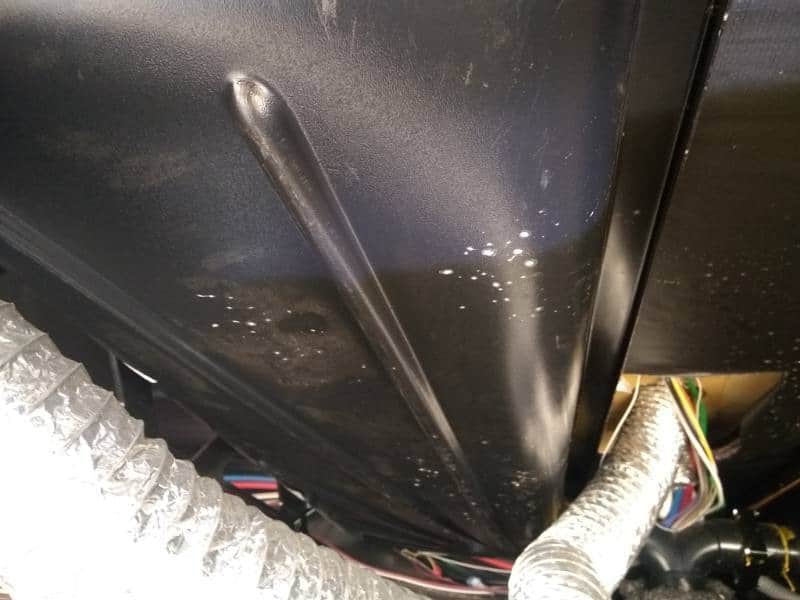In the same way that a jack-o-lantern represents Halloween or a bald eagle symbolizes ‘Murica, an RV is supposed to embody freedom: the open road, tomorrow’s adventures, fighting The Man.
But nothing is more disappointing than realizing your home-on-wheels wasn’t really designed for the road you love.
Don’t You Know You Can’t Travel with Water?
Here is a snippet from the Owner’s Manual for the 2015 Jayco Melbourne Class C motorhome:
Let me repeat that for the people in the back: “Never travel with full fresh, black or grey water holding tanks.”
That is what the manual says. The manual does not explain why. Many other manuals I’ve read heavily discourage traveling with full tanks, arguing that it will unnecessarily raise your Gross Trailer Weight (GTW), lower your Cargo Carrying Capacity (CCC), and handicap your handling.
There is an implication behind this prohibition, an implication I don’t like. You see, if you’re traveling to your local KOA, then sure, toting water isn’t necessary. There’s freshwater at your campsite and a dump station when you exit. But if you camp off the beaten path – maybe at Burning Man, maybe a local hunting camp, maybe at Cracker Barrel while you’re wandering across the country – then there are many valid reasons why you’d need to travel with full fresh or full waste tanks. So the implication is that your RV is made for the FHU campsite, not for the road to get there.
Did Your RV Water Tank Just Fall Off?

In fact, it’s not unknown for RV water tanks to fall off. That’s right – just fall/huck/yeet themselves onto the asphalt at 60 mph. Sometimes, all it takes is a pothole on I-20. Sometimes, they fall off when you’re standing still. You can read the conversation thread at the RV.net forum where dozens of RV owners swap stories of tanks falling off or coming undone.
Now, when was the last time your gasoline tank fell off the car? Or your kitchen sink dropped through the counter? Hmm, never?
One time, I was working at an RV factory when a gray water tank slid off the mounting brackets while moving down the assembly line. A quick inspection revealed the gray water tank wasn’t made within tolerance. It was too small. Out came the tape measures. We realized almost all the tanks from a certain delivery batch were out-of-spec.
So what’s the best solution? Have custom mounting brackets fabricated for the too-small tanks and pay the rush fee? Build the RVs and let them sit in the shipping yard until new inventory arrived? Ask the OEM to take responsibility for their mistake and wade through the finger-pointing? Blame our receiving clerk for not comparing the tanks to a blueprint before accepting them into stock?
Some RVs don’t even use steel brackets or straps. They just screw the flanges of plastic tanks directly to the subfloor and hope the plastic doesn’t break before the warranty expires.
A water tank, you see, weighs next to nothing when empty and a whole-lotta-somethin’ when full. A full 40-gallon tank weighs more than 330 lbs.; a full 100-gallon tank weighs 830 lbs.!That’s more than a full-grown tiger. When full, these tanks aren’t just heavy; they change shape. They try to collapse by bowing in the middle, and they can easily bend a thin metal frame to their will.
To add insult to injury, you usually can’t even inspect your tanks until you spend an afternoon dropping the continuous Coroplast underbelly, or you have to cut and seal an access hole you create yourself.
Another example: Here’s a YouTube video from an RV owner who discovered his freshwater tank had caused the chassis cross member to shear its fasteners:
When Will the RV Industry Wake Up?
This blog does not exist to bash the RV industry. I like this industry. But I am always struck by the difference in tone between the RV consumer blogs that I read online and the RV industry magazines I receive in my inbox. When the RV industry pats itself on the back for its latest merger or acquisition, the RV consumers complain that their brand-new rigs spent 8 out of their first 12 months at the dealership, waiting for parts and approval to fix issue after issue after issue.
Why do RV water tanks fall out? Or why don’t RV toilets have shut-off valves? Why don’t water pressure regulators come standard? Why don’t water pumps have a built-in flow sensor/safety switch to prevent dry priming? Why do most OEM tank-level sensors not work? Why is our best solution for dumping toxic human waste a 3” plastic slinky and a pair of gloves?
Something is rotten in the state of Indiana. We live in a society where your smartphone has more computing power than the Apollo 11 rocket and your car’s engine can last for 300,000 miles, but you can’t travel with the water you want in your own RV?? There is a growing discrepancy between what the RV industry makes and what the RV customer requires, and no amount of fine print in an Owner’s Manual will change that.
In the meantime, may I suggest some stainless steel fuel tank strapping?
Leave a Reply